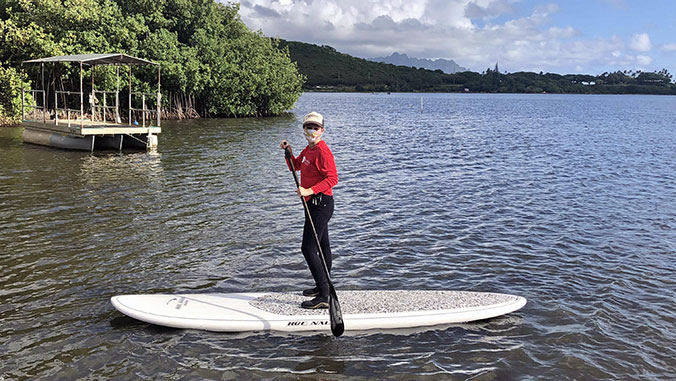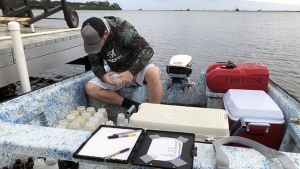
To improve the water quality in Heʻeia Fishpond and surrounding coastal areas, the University of Hawaiʻi Sea Grant College Program (Hawaiʻi Sea Grant) is leading a two-year project in partnership with Paepae o Heʻeia, Hui Kū Maoli Ola and Nā Kilo Honua o Heʻeia to remove invasive mangrove and hau (lowland tree) and install bioretention basins.
The project, funded by the Hawaiʻi Department of Health Clean Water Branch, builds on a previous successful project which resulted in considerable improvements to the ecosystem and water quality within the fishpond with the removal of invasive red mangroves.
Bioretention basins have been shown to reduce polluted runoff by up to 90 percent. The two bioretention basins installed during this project will be strategically placed in front of storm drain outlets that feed into Heʻeia Fishpond, which will allow the stormwater to collect, settle, then infiltrate into the ground slowly, reducing impacts to the fishpond.
- Related UH News story, Fishpond sees dramatic turn after removal of invasive plants, August 6, 2019
Water quality monitoring
Two UH Mānoa students in the School of Ocean and Earth Science and Technology’s marine biology graduate program will focus on water quality monitoring as part of the project. Becca Lensing and Hoaka Thomas will monitor concentrations of nutrient pollutants, sediment, microbial contaminants and circulation and flow rate in the fishpond.

“The research we’re doing, in partnership with the Department of Health and Paepae o Heʻeia, is really exciting,” Lensing noted. “Water quality analysis can provide measurements on how current biocultural restoration efforts are moving the fishpond to a more productive and sustainable habitat. This is especially important in a time where Hawaiʻi is trying to balance an ever-growing and culturally diverse population while maintaining its ties to the Hawaiian culture, and preserving sustainable practices like loko iʻa.”
“Paepae o Heʻeia is a leader in fishpond restoration and cultural stewardship of natural resources, so much of what we’re doing, in collaboration with all the science teams working with Paepae, is humbly groundbreaking and will set a precedent for future work in Hawaiian fishpond and wetland restoration,” Thomas added.
Paepae o Heʻeia’s work
Heʻeia Fishpond is 600 to 800-years-old and this project will play a critical role in the continued restoration of the pond. Abundant and clean fresh water is critical to Paepae o Heʻeia’s work in cultivating fish through Native Hawaiian aquaculture techniques, and more broadly to restoring fishponds across the Hawaiian Islands. In addition to growing fish, Heʻeia Fishpond collaborates with researchers to conduct cutting-edge research, and also provides a unique cultural learning environment for students and communities across the state.
“This project aligns with our restoration goals and vision for the fishpond, and gives us an opportunity to deal directly with the urban runoff that drains directly into the fishpond,” said Keliʻi Kotubetey, founder and assistant executive director of Paepae o Heʻeia. “These bioretention basins will help us capture storm water from over 50 homes and street surfaces, and hopefully make it as clean as possible before it enters the pond. Clean fresh water is critical to a healthy fishpond environment and clean seafood. This pond was originally built by many hands working in unison—laulima—and we continue that tradition by engaging our neighbors, students, families and volunteers in healing projects like this.”
–By Cindy Knapman

